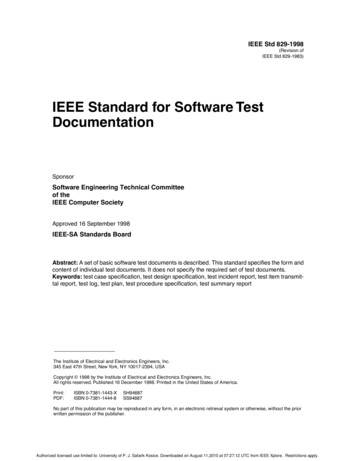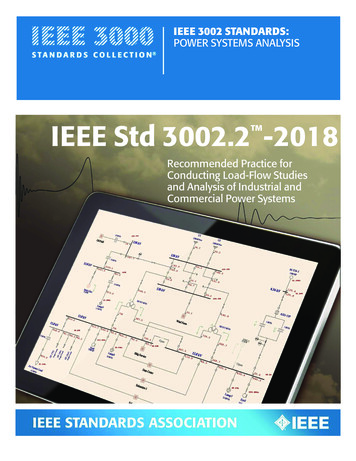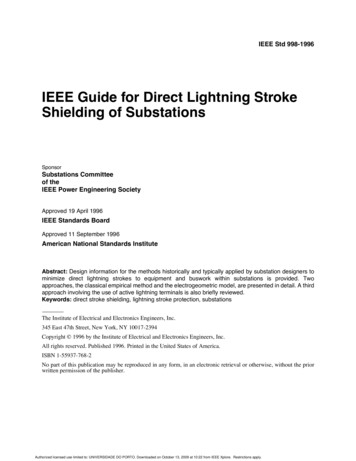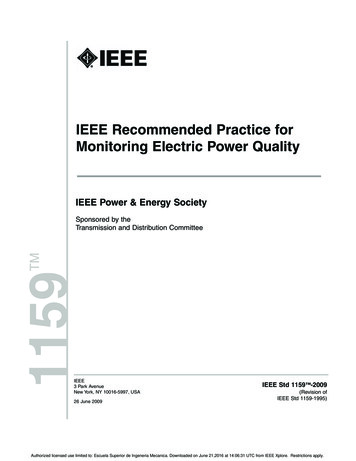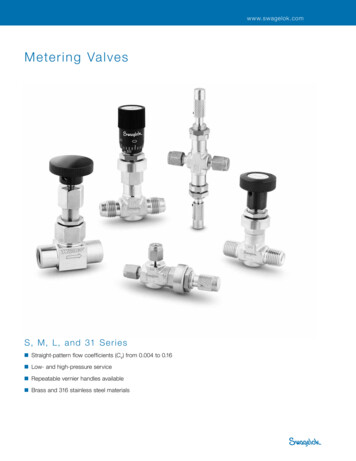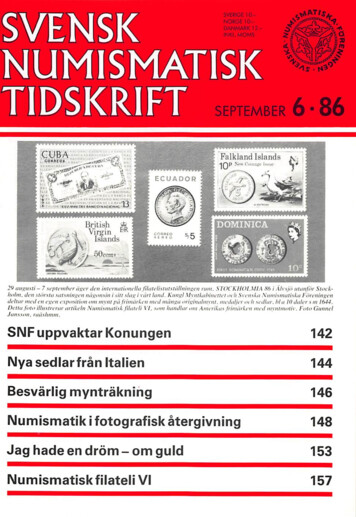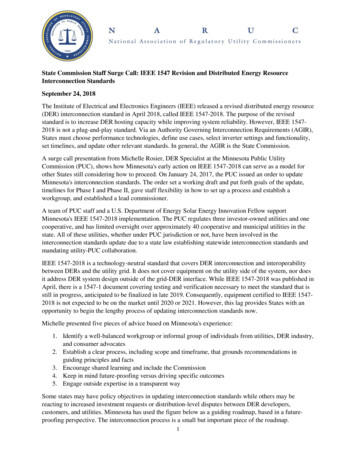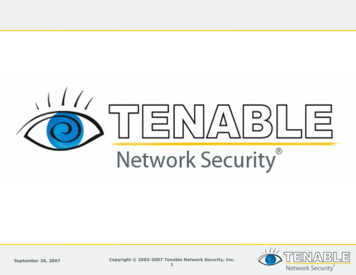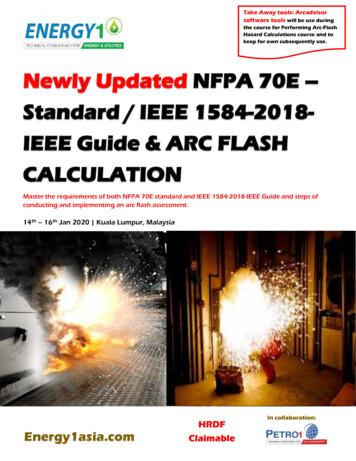
Transcription
BOOK greenIEEE142 IEEE Recommended Practice forGrounding ofIndustrial andCommercial PowerSystemsPublished by theInstitute of Electrical andElectronics Engineers, Inc.IEEE Std 142 -2007(Revision ofIEEE Std 142-1991)
IEEE Std 142 -2007(Revision ofIEEE Std 142-1991)IEEE Recommended Practicefor Grounding of Industrial andCommercial Power SystemsSponsorPower Systems Engineering Committeeof theIEEE Industry Applications SocietyApproved 7 June 2007IEEE-SA Standards Board
Abstract: The problems of system grounding, that is, connection to ground ofneutral, of the corner of the delta, or of the midtap of one phase, are covered. Theadvantages and disadvantages of grounded vs. ungrounded systems arediscussed. Information is given on how to ground the system, where the systemshould be grounded, and how to select equipment for the ground of the neutralcircuits. Connecting the frames and enclosures of electric apparatus, such asmotors, switchgear, transformers, buses, cables, conduits, building frames, andportable equipment, to a ground system is addressed. The fundamentals of makingthe interconnection of a ground conductor system between electric equipment andthe ground rods, water pipes, etc., are outlined. The problems of static electricity—how it is generated, what processes may produce it, how it is measured, and whatshould be done to prevent its generation or to drain the static charges to earth toprevent sparking—are treated. Methods of protecting structures against the effectsof lightning are also covered. Obtaining a low-resistance connection to earth, useof ground rods, connections to water pipes, etc., are discussed. A separate chapteron electronic equipment is included.Keywords: connection to earth, electronic equipment grounding, equipmentgrounding, lightning protection, static protection, system groundingThe Institute of Electrical and Electronics Engineers, Inc.3 Park Avenue, New York, NY 10016-5997, USACopyright 2007 by the Institute of Electrical and Electronics Engineers, Inc.All rights reserved. Published 30 November 2007. Printed in the United States of America.IEEE is a registered trademark in the U.S. Patent & Trademark Office, owned by the Institute of Electrical and Electronics Engineers, Incorporated.National Electrical Code and NEC are both registered trademarks in the U.S. Patent & TrademarkOffice, owned by the National Fire Protection Association.National Electrical Safety Code and NESC are both registered trademarks and service marks of theInstitute of Electrical and Electronics Engineers, Inc.National Lightning Detection Network (NLDN) is a registered trademark of Vaisala, Inc.Print:PDF:ISBN 0-7381-5639-6ISBN 0-7381-5640-XSH95700SS95700No part of this publication may be reproduced in any form, in an electronic retrieval system or otherwise, without the prior written permission of the publisher.
IEEE Standards documents are developed within the IEEE Societies and the Standards CoordinatingCommittees of the IEEE Standards Association (IEEE-SA) Standards Board. The IEEE develops its standardsthrough a consensus development process, approved by the American National Standards Institute, which bringstogether volunteers representing varied viewpoints and interests to achieve the final product. Volunteers are notnecessarily members of the Institute and serve without compensation. While the IEEE administers the process andestablishes rules to promote fairness in the consensus development process, the IEEE does not independentlyevaluate, test, or verify the accuracy of any of the information contained in its standards.Use of an IEEE Standard is wholly voluntary. The IEEE disclaims liability for any personal injury, property orother damage, of any nature whatsoever, whether special, indirect, consequential, or compensatory, directly orindirectly resulting from the publication, use of, or reliance upon this, or any other IEEE Standard document.The IEEE does not warrant or represent the accuracy or content of the material contained herein, and expresslydisclaims any express or implied warranty, including any implied warranty of merchantability or fitness for aspecific purpose, or that the use of the material contained herein is free from patent infringement. IEEE Standardsdocuments are supplied “AS IS.”The existence of an IEEE Standard does not imply that there are no other ways to produce, test, measure, purchase,market, or provide other goods and services related to the scope of the IEEE Standard. Furthermore, the viewpointexpressed at the time a standard is approved and issued is subject to change brought about through developmentsin the state of the art and comments received from users of the standard. Every IEEE Standard is subjected toreview at least every five years for revision or reaffirmation. When a document is more than five years old and hasnot been reaffirmed, it is reasonable to conclude that its contents, although still of some value, do not whollyreflect the present state of the art. Users are cautioned to check to determine that they have the latest edition of anyIEEE Standard.In publishing and making this document available, the IEEE is not suggesting or rendering professional or otherservices for, or on behalf of, any person or entity. Nor is the IEEE undertaking to perform any duty owed by anyother person or entity to another. Any person utilizing this, and any other IEEE Standards document, should relyupon the advice of a competent professional in determining the exercise of reasonable care in any givencircumstances.Interpretations: Occasionally questions may arise regarding the meaning of portions of standards as they relate tospecific applications. When the need for interpretations is brought to the attention of IEEE, the Institute will initiateaction to prepare appropriate responses. Since IEEE Standards represent a consensus of concerned interests, it isimportant to ensure that any interpretation has also received the concurrence of a balance of interests. For thisreason, IEEE and the members of its societies and Standards Coordinating Committees are not able to provide aninstant response to interpretation requests except in those cases where the matter has previously received formalconsideration. At lectures, symposia, seminars, or educational courses, an individual presenting information onIEEE standards shall make it clear that his or her views should be considered the personal views of that individualrather than the formal position, explanation, or interpretation of the IEEE.Comments for revision of IEEE Standards are welcome from any interested party, regardless of membershipaffiliation with IEEE. Suggestions for changes in documents should be in the form of a proposed change of text,together with appropriate supporting comments. Comments on standards and requests for interpretations should beaddressed to:Secretary, IEEE-SA Standards Board445 Hoes LanePiscataway, NJ 08854USAAuthorization to photocopy portions of any individual standard for internal or personal use is granted by theInstitute of Electrical and Electronics Engineers, Inc., provided that the appropriate fee is paid to CopyrightClearance Center. To arrange for payment of licensing fee, please contact Copyright Clearance Center, CustomerService, 222 Rosewood Drive, Danvers, MA 01923 USA; 1 978 750 8400. Permission to photocopy portions ofany individual standard for educational classroom use can also be obtained through the CopyrightClearance Center.
IntroductionThis introduction is not part of IEEE Std 142-2007, IEEE Recommended Practice for Groundingof Industrial and Commercial Power Systems.This book is a revision of IEEE Std 142-1991, the IEEE Green Book . Thisrecommended practice has served electrical engineers seeking electrical system groundinginformation since the first edition in 1956. It reflects the experience and sound judgmentof a working group made up of engineers active in the design and operation of electricalsystems for industrial and commercial power systems.Notice to usersErrataErrata, if any, for this and all other standards can be accessed at the following /errata/index.html. Users are encouraged tocheck this URL for errata periodically.InterpretationsCurrent interpretations can be accessed at the following URL: x.html.PatentsAttention is called to the possibility that implementation of this standard may require useof subject matter covered by patent rights. By publication of this standard, no position istaken with respect to the existence or validity of any patent rights in connection therewith.The IEEE shall not be responsible for identifying patents or patent applications for whicha license may be required to implement an IEEE standard or for conducting inquiries intothe legal validity or scope of those patents that are brought to its attention.ivCopyright 2007 IEEE. All rights reserved.
ParticipantsAt the time this standard was submitted to the IEEE-SA Standards Board for approval, theWorking Group had the following membership:Elliot Rappaport, ChairDaleep C. Mohla, Vice ChairChapter 1: System grounding—Donald W. Zipse and Gene Strycula, Co-chairsChapter 2: Equipment grounding—Elliot Rappaport, ChairChapter 3: Static and lightning protection grounding—Donald McCullough II andDonald W. Zipse, Co-chairsChapter 4: Connection to earth—Ken Michaels, ChairChapter 5: Electronic equipment grounding—Thomas Baldwin, ChairLarry AyerV. BaschBaldwin BridgerWilliam BushM. ButkiewiczThomas M. GruzsM. JerathDon O. KovalT. David MillsNeil NicholsMelvin K. SandersLynn F. SaundersSrinivasa I.VenugopaianThe following members of the individual balloting committee voted on this standard.Balloters may have voted for approval, disapproval, or abstention.Marcos AndradeRichard BeckerW. J. (Bill) BergmanThomas BlairWilliam BloetheStuart BoucheyBaldwin BridgerFrederick BrockhurstMark BushnellKeith ChowDonald ColaberardinoStephen P. ConradTerry ConradJames DalyStephen DareGuru Dutt DhingraGary Di TroiaGary DonnerRandall DotsonNeal DowlingDonald DunnRandall GrovesThomas M. GruzsPaul HamerRobert HoeraufDarin HuculRobert InghamDavid W. JacksonJoseph JancauskasYuri KhersonskyRobert KonnikDon O. KovalSaumen KunduStephen R. LambertBlane LeuschnerJason LinMichael LowensteinRichard LoydGregory LuriKeith MalmedalWilliam McCoyDonald McCullough IICopyright 2007 IEEE. All rights reserved.William MoylanMichael NewmanNeil NicholsGreg NolanT. W. OlsenGregory OlsonLorraine PaddenKostas PervolarakisPaul PillitteriPercy PoolLouie PowellElliot RappaportRadhakrishnaRebbapragadaMichael RobertsMelvin K. SandersSteven SanoRobert SchuergerRobert SeitzMichael ShirvenH. Jin Simv
Dan EvansJay FischerH. Landis Floyd IIMarcel FortinCarl FredericksEdgar GalyonTravis GriffithDavid SmithRobert SmithDevendra SoniPeter SutherlandJames WilsonLarry YoungDonald W. ZipseMark McGranaghanJohn MerandoJames MichalecGary MichelT. David MillsJames MitchemCharles MorseAbdul MousaWhen the IEEE-SA Standards Board approved this standard on 7 June 2007, it had thefollowing membership:Steve M. Mills, ChairRobert M. Gown, Vice ChairDon Wright, Past ChairJudith Gorman, SecretaryRichard DeBlasioAlex GelmanWilliam R. GoldbachArnold M. GreenspanJoanna N. GueninJulian Forster*Kenneth S. HanusWilliam B. HopfRichard H. HulettHermann KochJoseph L. Koepfinger*John KulickDavid J. LawGlenn ParsonsRonald C. PetersenTom A. PrevostNarayanan RamachandranGreg RattaRobby RobsonAnne-Marie SahaziziaVirginia C. SulzbergerMalcolm V. ThadenRichard L. TownsendHoward L. Wolfman*Member EmeritusAlso included are the following nonvoting IEEE-SA Standards Board liaisons:Satish K. Aggarwal, NRC RepresentativeAlan H. Cookson, NIST RepresentativeDon MessinaIEEE Standards Program Manager, Document DevelopmentPatricia A. GerdonIEEE Standards Program Manager, Technical Program DevelopmentviCopyright 2007 IEEE. All rights reserved.
ContentsChapter 1System grounding . 11.1 Introduction.11.2 Definitions.21.3 Purposes of system grounding .41.4 Methods of system neutral grounding.51.5 Obtaining the system neutral .221.6 Location of system grounding points.281.7 Grounding of industrial and commercial generators .381.8 Autotransformers .481.9 System grounding for uninterruptible power systems .531.10 Portable mining equipment supply systems.571.11 Creation of stray currents and potentials .601.12 Avoiding common-mode noise.621.13 Limiting transferred earth potentials.631.14 “Resonantly” produced voltages.641.15 Grounding of dc power systems .661.16 Normative references .701.17 Bibliography .73Chapter 2Equipment grounding.
IEEE Std 142 -2007 (Revision of IEEE Std 142-1991) IEEE Recommended Practice for Grounding of Industrial and Commercial Power Systems Sponsor Power Systems Engineering Committee of the IEEE Industry Applications Society Approved 7 June 2007 IEEE-SA Standards Board

